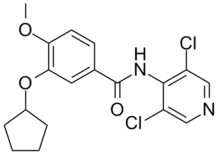Piclamilast
Piclamilast (RP 73401), is a selective PDE4 inhibitor.[1] It is comparable to other PDE4 inhibitors for its anti-inflammatory effects. It has been investigated for its applications to the treatment of conditions such as chronic obstructive pulmonary disease, bronchopulmonary dysplasia and asthma. It is a second generation compound that exhibits structural functionalities of the PDE4 inhibitors cilomilast and roflumilast. The structure for piclamilast was first elucidated in a 1995 European patent application.[2] The earliest mention of the name "piclamilast" was used in a 1997 publication.[3]
Mechanism of action
Piclamilast functions through the selective inhibition of the four PDE4 isoforms (PDE4A-D). It shows no inhibition of the other PDEs. The PDE4 isoforms are especially important to inflammatory and immunomodulatory cells. They are the most common PDE in inflammatory cells such as mast cells, neutrophils, basophils, eosinophils, T lymphocytes, macrophages, and structural cells such as sensory nerves and epithelial cells. PDE4 hydrolyzes cyclic adenosine monophosphate (cAMP) to inactive adenosine monophosphate (AMP). Inhibition of PDE4 blocks hydrolysis of cAMP thereby increasing levels of cAMP within cells. cAMP suppresses the activity of immune and inflammatory cells. PDE4 inhibition in an induced chronic lung disease murine model was shown to have anti-inflammatory properties, attenuate pulmonary fibrin deposition and vascular alveolar leakage, and prolong survival in hyperoxia-induced neonatal lung injury. A study of PDE4 inhibition in a murine model of allergic asthma showed that piclamilast significantly improves the pulmonary function, airway inflammation and goblet cell hyperplasia.[4][5]
Side effects
Emesis is the most commonly cited side effect of piclamilast. It has proven difficult to separate the emetic side effects from the therapeutic benefits of several PDE4 inhibitors, including piclamilast.[6]
References
- ↑ Beeh, K. M.; Beier, J.; Lerch, C.; Schulz, A. K.; Buhl, R. (2004). "Effects of Piclamilast, a Selective Phosphodiesterase-4 Inhibitor, on Oxidative Burst of Sputum Cells from Mild Asthmatics and Stable COPD Patients". Lung 182 (6): 369–377. doi:10.1007/s00408-004-2518-z. PMID 15765929.
- ↑ EP application 0497564
- ↑ Souness, J. E.; Houghton, C.; Sardar, N.; Withnall, M. T. (1997). "Evidence that cyclic AMP phosphodiesterase inhibitors suppress interleukin-2 release from murine splenocytes by interacting with a 'low-affinity' phosphodiesterase 4 conformer". British Journal of Pharmacology 121 (4): 743–750. doi:10.1038/sj.bjp.0701200. PMC 1564751. PMID 9208143.
- ↑ Sun, J.; Deng, Y.; Wu, X.; Tang, H.; Deng, J.; Chen, J.; Yang, S.; Xie, Q. (2006). "Inhibition of phosphodiesterase activity, airway inflammation and hyperresponsiveness by PDE4 inhibitor and glucocorticoid in a murine model of allergic asthma". Life Sciences 79 (22): 2077–2085. doi:10.1016/j.lfs.2006.07.001. PMID 16875702.
- ↑ De Visser, Y. P.; Walther, F. J.; Laghmani, E. H.; Van Wijngaarden, S.; Nieuwland, K.; Wagenaar, G. T. M. (2008). "Phosphodiesterase-4 inhibition attenuates pulmonary inflammation in neonatal lung injury". European Respiratory Journal 31 (3): 633–644. doi:10.1183/09031936.00071307. PMID 18094015.
- ↑ Hirose, R.; Manabe, H.; Nonaka, H.; Yanagawa, K.; Akuta, K.; Sato, S.; Ohshima, E.; Ichimura, M. (2007). "Correlation between emetic effect of phosphodiesterase 4 inhibitors and their occupation of the high-affinity rolipram binding site in Suncus murinus brain". European Journal of Pharmacology 573 (1–3): 93–99. doi:10.1016/j.ejphar.2007.06.045. PMID 17658510.
|
|---|
| | Adrenergics, inhalants | |
|---|
| | Glucocorticoids | |
|---|
| Anticholinergics/
muscarinic antagonist | |
|---|
| | Mast cell stabilizers | |
|---|
| | Xanthines | |
|---|
| | Eicosanoid inhibition | |
|---|
| | Others/unknown | |
|---|
| | Combination products | |
|---|
| |
|---|
| | Description |
- Anatomy
- Physiology
- Development
|
|---|
| | Disease |
- Congenital
- Neoplasms and cancer
- Chest trauma
- Infection
- common cold
- pneumonia
- tuberculosis
- Other
- Symptoms and signs
|
|---|
| | Treatment |
- Procedures
- Drugs
- nasal
- throat
- obstructive airway diseases
- cough and cold
- histaminergics
- pulmonary arterial hypertension
- other
- Surgery
|
|---|
|
|
